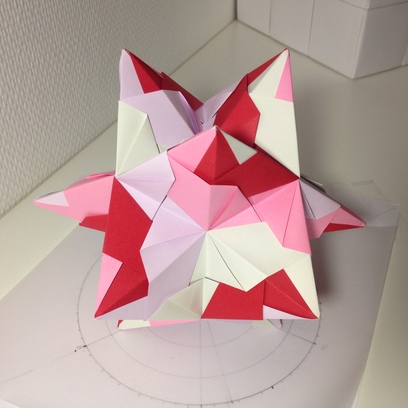Origami part 3 : Rhombic Polyhedra
Created on August 22, 2018. Last update on January 2, 2019.
I found out about rhombic polyhedra with two videos. The first one is a video from standupmaths [3] where he makes a rhombic Bilinski’s dodecahedron out of cardboard. The second one is from Micmaths about the flexahedron [1] where the rhombic dodecahedron (not Bilinski’s) appears as one of the forms the flexahedron can take. It is described as the complementary shape (not the dual) of the cube. The rhombic dodecahedron is a polyhedron made of 24 faces of the same rhombus (with a diagonal ratio of 
Some time after finishing the augmented platonic solids, I was wondering which other shapes I could make and I remembered these videos (I also had made the flexahedron in the mean time). I dug around to find if other people had built the rhombic dodecahedron in its augmented version with the same origami module I used for the platonic solids but I could not find any.
I was also looking for other rhombic polyhedra and I found a great website with interactive 3D models of many polyhedra [2]. On this website, I discovered additional polyhedra. In the Catalan solids section (where the rhombic dodecahedron is listed), I found the rhombic triacontahedron and the rhombic icosahedron. The rhombic icosahedron is obtained from the rhombic triacontahedron by removing a strip of rhombuses close to the equator. I personally see it as a flattened version of the triacontahedron. In the "Others" section are the rhombic enneacontahedron and hexecontahedron together with Bilinski’s dodecahedron. The rhombic hexecontahedron is not convex though. The enneacontahedron has too many edges (120) for me to make any time soon (remember the manual colorization + the folding time) and it is made of two types
of different rhombuses (with diagonal ratios of 

The diagonal ratio of the rhombuses that make Bilinski's dodecahedron, the rhombic icosahedron, triacontahedron and hexecontahedron is equal to the golden number Φ. So, they are part of the family of the golden rhombic solids. Actually, they are a combination of two simpler solids, the acute and oblique rhombohedra which are obtained by deforming the square faces of a cube into golden rhombuses. In the acute rhombohedron, three rhombuses meet at two opposite vertices along their smaller angle whereas in the obtuse rhombohedron, they meet along their larger angle.
Coloring
Following the coloring scheme of the platonic solids, the minimal coloring number of these three rhombic polyhedra is also equal to the number of edges of a rhombus face: 4, see Table 1. However, I took a different approach to coloring the rhombic icosahedron and triacontahedron. For the triacontahedron, I wanted to also have the edges connected by the same vertex in the base form to have different colors. Since the number of edges meeting at the same vertex is either 3 or 5, the minimal coloring number in this case is 5. I did the manual coloring accordingly (it was tough though). For the icosahedron, I had the same approach with 5 colors × 8 edges but I had a lot of extra orange paper. So, I chose to modify the original coloring around two opposite vertices, the ones with 5 meeting edges, and color these edges with the same color (orange). In the end, I have 16 edges of 1 color and 6 edges × 4 colors. I think there are possibly other ways to color the rhombic icosahedron (without the orange recolorization).
| Solid name | #edges/modules | #colors for a face | #colors at a vertex |
|---|---|---|---|
| Rhombic Icosahedron | 24 | 4 | 5 |
| Rhombic Dodecahedron | 40 | 4 | 4 |
| Rhombic Triacontahedron | 60 | 4 | 5 |
The color themes for the three rhombic polyhedra are clearer than for the platonic solids. "Levels of red" for the dodecahedron, "Fire" for the icosahedron, "Secret garden of summer" for the triacontahedron.
Problem with pyramids
I should mention at this point, and it took me a long time to realize, that once the augmented model is mounted, the base polyhedron (that you obtain by considering the main crease of each module) is no longer what I wanted in the first place even though I still obtained a wonderful origami model. Let me explain what I mean.
The augmented version of a polyhedra is made by forming pyramids for each of the base faces but this is only true for base faces that are regular polygons. This pyramid is made of triangle sides that are all the same isosceles triangle and a flat base face. The main constraints of the origami module is that it makes two isosceles triangles but you can’t make a pyramid with isosceles sides and a rhombus base (apart from a square base). The rhombus base can’t be flat so the pyramid is deformed onto something else (a triangular bipyramid with two kind of faces, a triangulated folded rhombus and the origami isosceles triangles). Consequently, the origami model is not the augmentation of a rhombic polyhedra.
However, it does not really matter so much for now since as I said, the origami model is still pretty but we will come back to it in Section ??.
Gallery
The models I made and the graphs I used can be found in Figures 2, 3 and 4.
References
[1] Mickaël Launay. Le flexaèdre - micmaths. https://www.youtube.com/watch?v=Kg3_gLO-_reE. Accessed on 08-11-2018.
[2] David I. McCooey. Visual polyhedra. http://dmccooey.com/polyhedra/. Accessed on 08-11-2018.
[3] Matt Parker. A new rhombic dodecahedron from Croatia! https://www.youtube.com/watch?v=xVBOlbjiHGI. Accessed on 08-11-2018.










